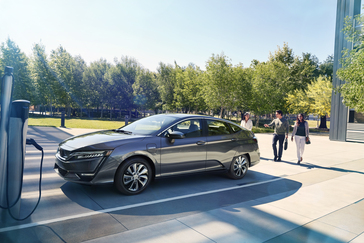Honda sets a sales target of 100% zero-emission electrified vehicles in North America by 2040, part of its campaign for all its products and corporate activities to achieve carbon neutrality by 2050.
The automaker says its goal is for battery-electric and fuel-cell vehicles to comprise 40% of sales by 2030 and 80% by 2035. Volume production of new EV models based on what Honda calls an e:Architecture platform is to begin in the 2024 model year.
While Honda will independently develop the e:Architecture for vehicles launching in the second half of the 2020s – first in North America, followed by other regions of the world – the automaker also is developing two “large-sized” EVs using General Motors’ Ultium batteries.
Those models, one from the Honda brand and one from the Acura brand, will be introduced to the North American market as ’24-model-year vehicles.
Other highlights of Honda’s announcement:
- The sales target of 100% electrified vehicles by 2040 is limited to North America “due to regional differences such as the level of customer acceptance, readiness of infrastructure and availability of renewable energy,” making it “difficult to adopt a singular approach to the popularization of electrified vehicles globally.”
- The automaker intends to make all-solid-state batteries available for new Honda EV models to be introduced in the second half of the 2020s.
- While continuing its current collaboration with GM, Honda plans to expand its lineup of FCEVs and use fuel cell systems for a wide range of applications, including commercial trucks and stationary and portable power sources.
- Honda will attempt to develop a “multi-pathway of energy” that includes carbon-neutral fuels which will be effective in all areas. This includes areas where application of electrification is difficult, such as with aircraft. Honda also will work to expand utilization of renewable energy by enabling infrastructure-linked, smart-power operations when charging these products.
- The automaker says it has taken significant steps to supplying its operations with 100% renewable energy. Honda has entered into long-term virtual power purchase agreements for renewable wind and solar power that cover more than 60% of the electricity the company uses in North America. These agreements enable the automaker Honda to fully offset the remaining carbon-intensive, grid-supplied electricity being used in its Ohio, Indiana and Alabama vehicle manufacturing operations.
- In addition to carbon neutrality, Honda announces it is targeting zero traffic collision fatalities involving Honda automobiles and motorcycles globally by 2050. As part of that effort, the company will work to add omnidirectional ADAS (advanced driver-assistance system) to its Honda Sensing technologies to all new automobile models introduced in advanced nations by 2030.
Honda, citing data from the U.S. Environmental Protection Agency, claims it already has the highest fleet average fuel economy and lowest CO2 emissions of any full-line automaker in the U.S. The Wards Intelligence Fuel Economy Index places Honda No.1 in calendar and model year 2020, but slightly behind Toyota and Mitsubishi for 2021.
The automaker currently produces five electrified vehicles: hybrid versions of the Accord and Insight sedans and CR-V crossover; the Clarity plug-in hybrid; and the Clarity FCEV. Honda discontinued sales of its battery-electric Clarity (pictured, below), the only BEV it offered in the U.S., after the 2020 model year.






